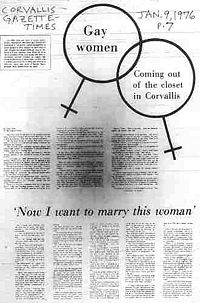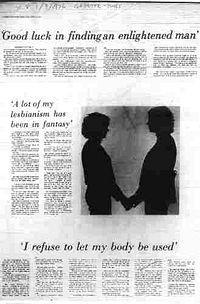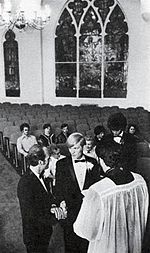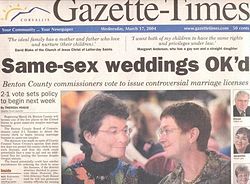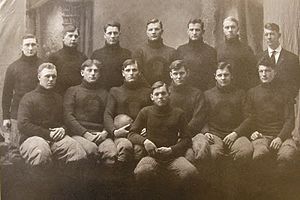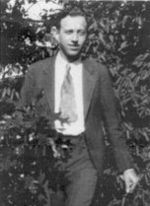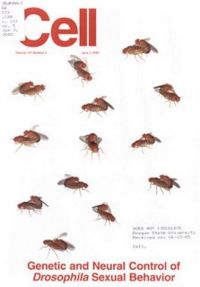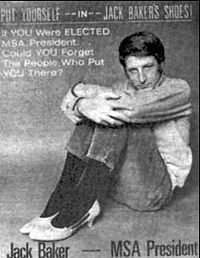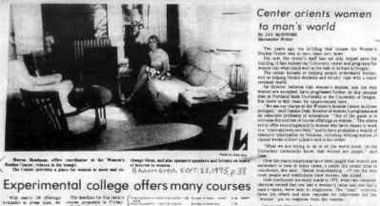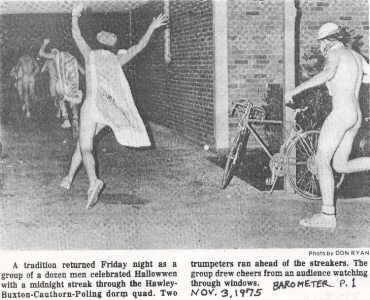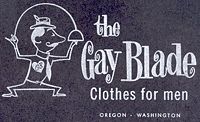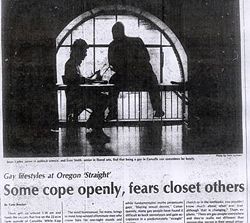Corvallis, Oregon State University gay activism 1969-2004
Corvallis, Oregon State University gay activism: 1969-2004
This exhibit describes post-Stonewall gay activism at Oregon State University in Corvallis, Oregon and events that motivated the formation of the first officially recognized gay student group at OSU in 1976. [1]
Corvallis, Oregon is a traditional rural college town that has been the home of Oregon State University for more than a century. The population of Corvallis only recently exceeded 50,000 people, including the more than 20,000 OSU students.
OSU has historically attracted more conservative students to research and educational programs in forestry, engineering and agricultural science because of these fields importance to the local economy. More liberal students and those seeking a strong liberal arts program have historically favored other state colleges, such as the University of Oregon, 40 miles to the south in Eugene, Oregon. U of O students used to refer to OSU as "Oregon Straight" or the "cow college" in reference to the cows actually being raised on campus for various research programs. Conservative OSU students frequently stereotype U of O students as being "marijuana smoking hippie peaceniks" that go to a "party school." Therefore, it was surprising that the formation of a gay student group at OSU in 1976 initially drew no response from the predominantly straight and anti-gay Christian Republican OSU students.
Corvallis, Oregon is located across the Willamette River from Albany, Oregon, the birthplace of "Alberta Lucille Hart" who lived as the man "Alan Hart" in the early part of the 20th century. Hart's story is documented in Jonathan Ned Katz's 1976 "Gay American History" book and 1983 "Gay/Lesbian Almanac." [2] [3] (See the following pages on this site: Alan Hart: "The Undaunted," 1936, Alberta Lucille/Alan Hart (1890-1962) and J. Allen Gilbert: "Homosexuality and Its Treatment," October 1920.)
Gay marriage issue 1976
A 1976 Corvallis, Oregon newspaper story "Gay women: Coming out of the closet in Corvallis, 'Now I want to marry this woman,'" sparked numerous angry letters to the editor about such a thing being printed in a "family newspaper." Several letters threatened to cancel the writer's newspaper subscription. (In the 1970s, both gay men and lesbians identified as being gay until many women adopted a lesbian identity after objecting to rampant misogyny and sexism by gay male activists.) One of the women profiled in the newspaper story also came out in a letter to the editor of her student newspaper. She was active in forming gay women's groups at Oregon State University. [4] [5]
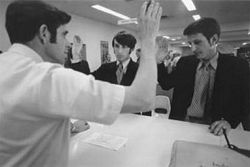
Although the woman profiled in the 1976 newspaper story considered gay marriage to be only an emotional feeling that was an impossible dream, others believed it was important to establish the actual equal right to marriage. For example, when her feelings about gay marriage were being quoted in 1976, another OSU graduate student Thomas Kraemer had for years been actively supporting the gay marriage activism of the University of Minnesota law student Jack Baker and Rev. Troy Perry. Jack Baker famously took his marriage case all the way to the U.S. Supreme Court and lost in 1972. Kraemer, when he was an undergraduate at the University of Minnesota between 1969 and 1974, had been a member of Jack Baker's F.R.E.E. (Fight Repression of Erotic Expression) gay liberation group. [7]
In the 1970s, most gay activists dismissed the idea of gay marriage as being contrary to the goals of both sexual and gay liberation. Baker and Rev. Perry were angrily denounced as being lunatics, even by other gay people. [8]
The woman profiled in the 1976 newspaper story, along with several other students including Thomas Kraemer, formed the first officially recognized student group at Oregon State University in 1976. [9]
In Oregon, marriage licenses are issued by county officials. In 2004, the elected Benton County commissioners (where Corvallis is located) voted to issue gay marriage licenses. A few months later, a bare majority of Oregon voters banned same-sex marriages with a state constitutional amendment. The costly signature gathering process needed to get it on the ballot was sponsored by anti-gay Christian Republicans as part of President George W. Bush's national reelection strategy.
Oregon State University gay students 1908-2010
Gay Oregon State University students existed long before they became open on campus. Research by community historian George Painter of the Gay and Lesbian Archives of the Pacific Northwest (GLAPN) found George Hastings, an Oregon State University football player in the 1908 and 1910 seasons, was one of the men linked to gay men arrested in the moral panic of 1912 that was fanned by a Portland, Oregon newspaper. Tellingly, the description of George Hastings in the 1912 yearbook (p.164) uses a euphemism for gay by saying, "He is considerably lighter than any other halfback playing in the Conference." Hastings weighed only 135 lbs and was skilled at evading tacklers. As a result, he was nicknamed "The Artful Dodger." [10]
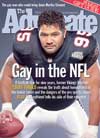
Another gay football player, Esera Tuaolo is probably the most famous openly gay graduate of Oregon State University. Unfortunately, he felt it was necessary to remain in the closet as a student athlete in the late 1980s and during his career as an NFL football player. Professional sports, especially football, remains today as one of the few places in American society where there are few openly gay people. Clippings about Tuaolo are available in the OSU Valley Library Oregon Multicultural Archives. [11] [12] [13]
Today, a few Oregon State University students are totally open about their sexuality and freely appear in the campus newspaper and electronic media without experiencing any overt homophobia. Unlike decades ago, nearly all OSU students today treat being gay as if it were no big deal politically. However, many gay OSU students today are still fearful and unsure about coming out too publicly on campus. Some worry about becoming victims of harassment or violence. Others worry about coming out causing a negative effect on their future professional careers. Career minded students are rightfully fearful because a few of the large corporate employers that recruit on campus have outright refused to adopt a non-discrimination policy for gay employees. Although OSU and the city of Corvallis are very gay-friendly, homophobic voters nationwide and anti-gay churches have sent out a clear message of hate by opposing same-sex marriages.
Gay Oregon Professor W. Dorr Legg 1935
Although queer students and staff at Oregon State University were not out of the closet until the 1970s, they for sure existed. For example, W. Dorr Legg (1904-1994) in 1935 was appointed to be an assistant professor of landscape architecture at a state university in Oregon. Dorr Legg was a founder of the "homophile" activism movement. He was also a founder of what was to become the present day gay Republican Log Cabin Club. (Note: various historical accounts disagree whether this was the University of Oregon in Eugene or Oregon State University in Corvallis. The confusion is likely because OSU has changed its name several times over the years and historians from out-of-state often confuse the two colleges.) [14] [15]
Oregon State University gay research circa 2000
Oregon State University in Corvallis, Oregon has world-class facilities and faculty that have conducted research on animal's sexual orientation. Although the main goal of their research is to understand the fundamentals of biology and genetics, it hits directly at the "nature vs. nurture" question: "Is being gay a choice?" Ex-gay preachers and social constructionists believe that being gay is a choice or at a minimum it is defined by society or the individual. Biological essentialists believe that sexual orientation is hardwired in either at birth or very early in the development of an animal. Some people consider the answer to be important because many people believe discrimination against a "gay lifestyle choice" should be legal. Some believe that discrimination against gay people will be outlawed if it can be proved that sexual orientation is immutable as the color of your skin. However, others believe the "nature or nurture" question is irrelevant because even race is a social construction and they point out that religious discrimination is illegal despite the fact that you can choose your own religion.
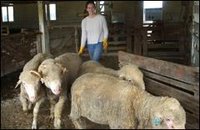
Similar to all higher-level animal research, Oregon State University's research on gay sheep has drawn protests from PETA (People for the Ethical Treatment of Animals). Also, some gay activists object to this research because they worry it will be misused to establish that homosexuality is a pathological disorder that can be treated or cured. After all, the ultimate experiment to understand the origins of same-sex behavior in animals is an experiment that can arbitrarily turn on or off homosexual behavior by modifying an animal's genetics or development process in a controlled manner.
An interesting finding from the gay sheep research is that a certain percentage of sheep are asexual in addition to the existence of gay and bisexual sheep in nature. Decades ago, Alfred Kinsey observed a similar percentage of asexual humans. [17] [18] Commercial breeders have always considered homosexual and asexual sheep to be a waste of resources because they won't breed. Much of the early research has been aimed at finding ways to detect and eliminate such sheep early in their development to increase breeding efficiencies. [9] [19]
Same-sex Drosophila (aka "gay fruit fly") sexual behavior has been a lab curiosity for decades. Common fruit flies are a favorite research animal because they are easy to breed in large numbers and their biological structures are orders of magnitude simpler than many other animals. Unlike most academic research topics, fruit fly research papers are difficult to understand even by scientists trained in a related field. However, it is clear to educated observers that fruit fly researchers, including those at Oregon State University, have made great progress toward being able to arbitrarily turn on or off certain characteristics in fruit flies, including their sexual orientation. How this knowledge will extrapolate to a better understanding of human biology is yet to be determined. The human question is not being ignored because both gay fruit fly research and gay sheep research is being conducted in collaboration with researchers at the Oregon Health Sciences University medical school and hospital for humans in Portland, Oregon approximately eighty miles north of Corvallis. [9] [20]
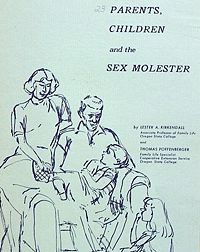
Academic research on homosexuals occurred long before the 1969 Stonewall riot. For example, Oregon State University professor Lester A. Kirkendall was recognized worldwide as one of the early academic sex researchers who sought to bring rationality to sex research. During the anti-communist and anti-gay moral panic of the 1950s started by Sen. Joe McCarthy, Oregon leaders asked the learned and distinguished Dr. Kirkendall to write a small pamphlet for Oregon parents to read about the threat of homosexuality. Typical of the era, the first paragraph of Kirkendall's 1953 eight-page booklet more or less equated homosexuals with child molesters, but later in the booklet Kirkendall correctly says that "sexual deviates" are not all child molesters and that child molestation does not cause "sexual deviance" while repeating the dogma of his time:
"We used to call people who did these things perverts, implying that their form of sexual expression was deliberately chosen. We classed these people with the town drunk and believed that if they only had more "will power" they would stop their evil ways. Today we know the alcoholic and the sex deviate both are really sick people who cannot be cured by punishment, but who may be helped by scientific diagnosis and treatment." [21] [22]
Timeline
The creation of the first officially recognized gay student group at Oregon State University in 1976 was inspired by similar types of student activism at OSU and other universities. The contemporaneous women's liberation movement and the 1969 Stonewall riot were key motivators. Below is a timeline of key events which influenced the history of OSU gay student groups. [23] [24]
October 1964
University of California Berkeley students start the "Free Speech Movement." Longtime Corvallis, Oregon resident, Dunbar Aitkens, is a participant. Aitkens was one of the leaders of early gay rights activities in Corvallis, Oregon. [25]
April 1967
Columbia University (New York) officially recognizes the "Student Homophile League" as a student group. [26] [27]
June 1969
Stonewall Inn riot in New York City marks a shift from the older generation of conservative homophile activists to a younger, more militant type of gay activist. [26] [27]
October 1969
University of Minnesota officially recognizes a student club for "gays and sympathizers" called F.R.E.E. (Fight Repression of Erotic Expression). University of Minnesota's Board of Regents tightens club recognition policy in response. [26] [27]
March 1970
University of California Berkeley students stage "gay power" demonstrations and guerrilla theater skits. Longtime Corvallis, Oregon resident and gay activist, Dunbar Aitkens, is arrested for doing with another man in public what heterosexual couples regularly do in public without being arrested. [28]
May 1970
University of Minnesota F.R.E.E. group issues press release to announce that Jack Baker and Michael McConnell will be applying for a marriage license. Minnesota marriage law does not specify gender. University of Minnesota's Board of Regents vote to withdraw a librarian job offer from Michael McConnell in response to his marriage announcement. [6] [26] [27]
July 1970
University of Nebraska approves Prof. Louis Compton's homophile studies course. [26] [27]
April, 1971
University of Minnesota, openly gay, law student Jack Baker is elected to his first of two terms as student body president. [6] [26] [27]
May 1971
Oregon repeals the state sodomy law as part of a comprehensive overhaul of blue laws. Previously, Oregon's sodomy law had been changed after an anti-gay moral panic of 1912 that resulted in the arrest of many gay men. The old sodomy law specified a punishment of up to 15 years in jail and it prudishly defined sodomy as being both anal sex and oral sex including the licking of the anus or genitals by either homosexuals or heterosexuals. This is why liberal heterosexual state legislators supported the change, even though they were forced to make a compromise raising the age-of-consent to 18. [26] [27] [29] [30] [31]
June 1971
Columbia University Students protest the college president and black student group's claim that gays are not a legitimate minority. [26] [27]
July 1971
University of Kansas refuses to recognize gay student group. Famous civil rights attorney William Kunstler agrees to take the case, but loses it on appeal when the Supreme Court refuses to hear the case. [26] [27]
October 1972
University of Minnesota law student Jack Baker has his marriage license revoked by a U.S. Supreme Court ruling that said his appeal was "dismissed for want of substantial federal question." The court essentially said that marriages are defined by state and not federal laws. [6] [26] [27]
January 1973
Oregon school teacher Peggy Burton, who had been fired for being a lesbian, wins in federal court, but loses two years later when the Supreme Court refuses to hear the case. [26] [27]
January 1973
Oregon State University Women's Study Center opens as a six month experiment. The Women's Center is a success and it permanently occupies an old building that was about to be demolished. It soon became the center of gay activism at OSU until 2004 when the Pride Center building opened. [32] [26] [27]
December 1973
American Psychiatric Association votes to remove homosexuality from the official list of mental disorders. Today, coercive medical treatments that attempt to change a person's sexual orientation have been banned by all major health organizations for being unethical. [26] [27]
Campus ex-gay groups predated gay-friendly student groups. These groups were usually led by a campus minister who wanted to "help" homosexual students become straight via prayer and unethical psychotherapy. Today, several Corvallis churches are still sponsoring ex-gay groups on campus. Ex-gays typically settle for celibacy because most admit to retaining their same-sex desires for ever.
June 1974
Portland, Oregon and Los Angeles police are caught illegally keeping secret files on citizens they suspect of being homosexual. Police defend their actions as needed to fight "terrorism." [26] [27]
December 1974
Portland, Oregon city council votes 3-2 to ban anti-gay discrimination in municipal employment. [26] [27]
June 1975
University of Oregon journalism graduate, Randy Shilts, is hired as a reporter for The Advocate (then a national gay newspaper) by the editor John Preston. Both men later become well known gay authors. Randy Shilts is most famous for his reporting on AIDS for the San Francisco Chronicle during the 1980s before he died from AIDS. [26] [27]
October 1975
Oregon State University Experimental College classes on homosexuality included: "Gay Women's Consciousness Raising" (Instructor: Peggy Jo Nulsen); "FREE 2 B U.N. ME!" (Instructors: Steve Rowe and Dunbar Aitkens of 1460 SW 'A' Avenue); and "Sexual Stereotypes in the Bible" (Instructor: Eric Landau, who represented the then anti-gay campus religious organization Westminster House) [33]
October 1975
Oregon State University Black Cultural Center officially opens at 2320 NW Monroe. [34]
November 1975
Front page of Barometer features the resignation of the legendary Oregon State University football coach and soon to be athletic director, Dee Andros, directly above a photograph of naked OSU streakers. [35]
January 1976
Oregon State University student newspaper, "The Barometer," prints an editorial by managing editor Bob Goldstein defending the two-page long Corvallis Gazette-Times newspaper article featuring lesbians who wanted to get married. The G-T was flooded with angry letters and subscription cancellations for just mentioning homosexuality in a so-called "family newspaper." [36] [4] A letter to the editor of "The Barometer" by longtime Corvallis, Oregon resident Dunbar Aitkens and Steve Rowe praises the editor's position, but student John Wilkins writes in to accuse the editor of having poor judgment and no values. [37] [38] One of the women profiled in the article came out in a letter to the editor of her student newspaper and she was active in early gay women's groups at Oregon State University.
March 1976
Oregon State University Native American Longhouse is dedicated March 23, 1976 in a blessing ceremony led by Gilbert Walking Bull. [39]
March 1976
Oregon State University announces that tuition will be $179 per term ($240 per term including incidental fees such as $16.50 for health insurance). Dormitory room and board (with 19 meals per week plan) in Weatherford Hall is projected to cost $1,140 per school year. Typical student jobs pay less than two dollars per hour. [40]
April 1976
Oregon State University Barometer April Fools Day edition includes an advice column headlined, "Lassie not gay." The column's "Mr. Answer" claims that the rumors about the popular TV dogs Lassie and Rin Tin Tin being married to each other are not true. This joke is culturally significant because homosexuality has historically been associated with bestiality. [41]
April 1976
Oregon State University student projectionist refuses to show the sexually graphic movie "Emmanuelle" because it violated his Christian values. He ends up instead showing the violent and bloody movie "Dirty Harry," starring Clint Eastwood. The hypocrisy of this is pointed out in a letter to the editor by longtime Corvallis resident and gay activist Dunbar Aitkens. [42]
May 1976
Ronald Reagan holds a rally on the Oregon State University campus while running against President Gerald Ford in the Oregon Republican Primary. Reagan does not win the presidency until 1980. President Reagan was highly criticized in the 1980s for his delayed reaction to the AIDS tragedy. [43]
September 1976
A print ad for "The Gay Parfait" restaurant and ice cream parlor at 340 N.W. 5th Steet appears in the Barometer. Also located in downtown Corvallis was a men's clothing store named "The Gay Blade." Both businesses eventually dropped the word "gay" from their names after "gay" became commonly associated with being homosexual. [44]
September 1976
National Organization of Women (NOW) chapter is organized in Corvallis. Many lesbian women were actively involved in starting the women's movement. [45]
October 1976
Oregon State University black cultural center is vandalized and a burning cross is placed on the front lawn. Several students are caught and the university president gives them an "unspecified punishment," which upsets many people on campus as being too lenient. [46]
October 1976
Society for the Advancement of Women (SAW) is denied funding by the student council. [47]
October 1976
Oregon State University Barometer editor, Bob Goldstein, writes an editorial on sex change operations titled "New type of sexism." This is the first mention of transsexual or transgendered people in the Barometer. Intersex conditions would not be mentioned until years later. [48]
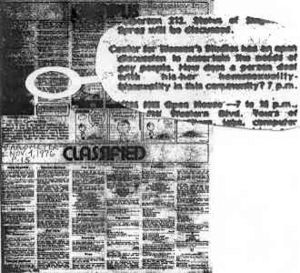
November 1976
Oregon State University gay students meet on November 4 in the Women's Center to form the first officially recognized gay student group. The weekly meeting agendas are discreetly printed with tiny 6-point type in the Barometer student newspaper's "Campus" calendar section. The microfilm copies are nearly illegible, but the complete text of each meeting announcement is as follows:
November 4, 1976
Center for Women's Studies has an open discussion to ascertain the needs of gay people. How does a person deal with "his-her" homosexuality-bisexuality in this community? 7 P.M. [49]
November 11, 1976
Gay men and women meeting - 7 PM - Center for Women's Studies. Discuss needs of gay men and women in this community. How does one deal with "his-her" homosexuality-bisexuality? [50]
November 18, 1976
Gay people - 7 PM - Center for Women's Studies. Meet to plan social and educational activities. [51]
December 2, 1976
Gay people - 7 PM Center for Women's Studies. Discuss organization and future activities. [52]
April 1977
Oregon's Multnomah County Medical Association polls Portland area doctors and finds that 80 percent would refuse to treat gay patients. This problem became even worse when AIDS struck in the 1980s. Medical professionals often refused to treat gay men due to the fear of getting AIDS. Furthermore, many doctors continued to treat homosexuality as a mental illness despite the 1973 decision by the American Psychiatric Association and later decisions by other mental health organizations. [26] [27]
June 1977
Eugene, Oregon's city council votes 5-3 to make it illegal to discriminate against homosexuals. [26] [27]
May 1978
Eugene, Oregon citizens vote (61 percent to 39 percent) to repeal the city's ordinance protecting homosexuals from discrimination. Local anti-gay leaders wisely rejected help from singer Anita Bryant's national religious organization which was lobbying to repeal similar laws in other cities across the country. Instead of trying to convince non-religious Eugene voters with Anita Bryant's religious based argument, opponents of the pro-gay ordinance falsely claimed it was a "special right," which was not needed because homosexuals were already protected under law. An anti-gay Colorado campaign in the 1990s also adopted this non-religious "no special rights for gays" political slogan and in 2004 Oregon backers of an anti-gay marriage amendment successfully duped voters with it again. [26] [27]
May 1978
Oregon congressman U.S. Rep. James Weaver of Eugene is targeted for defeat by national Republican groups because he sponsored a federal gay non-discrimination act. Political operatives attended church meetings and smeared Weaver by calling him "anti-Christian" and "anti-family." Gerrymandering has historically included all of Eugene and parts of Corvallis within Weaver's congressional district. [26] [27]
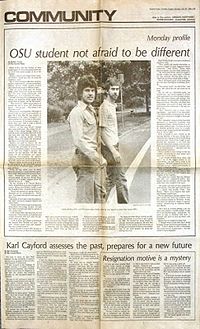
May 1982
Eddie Hickey's GPA (Gay People's Alliance ) student group funding request for the 1982-1983 school-year of $100 culminated unsuccessfully in 1982 after a heated campus-wide debate. [53] The $100 request was out of a total student incidental fees budget of over $4,400,000. ($87.78 per term incidental fees times 3 terms times 16,743 students enrolled) [54] [55] [56]
April 1984
The discovery of HIV being the likely cause of AIDS is announced. Many people associated with Oregon State University died of AIDS, including Eddie Hickey and his lover Scott. Anti-gay politicians cruelly exploited the AIDS tragedy to demonize homosexuals and to justify the firing of gay workers. Before a test for HIV was developed, gay men were rationally barred from donating blood to prevent infecting others. Today, even celibate and HIV negative gay men are still barred from donating blood even though a government medical advisory panel sees no reason for keeping this ban other than prejudice. [57] [26] [27]
May 9, 1984
OSU Newsmagazine in-Edition, May 9, 1984 cover story by Tami Brucker, "Lifestyles, Happy and Gay at OSU" was inserted in the official student newspaper The Daily Barometer. The feature article "Gay lifestyles at Oregon 'Straight,' Some cope openly, fears closet others" did an astounding job covering many aspects of "gay lifestyles" at Oregon State University. The article also summarized the history of Eddie Hickey who lobbied the student government to fund the gay student group and who along with his lover Scott later died from AIDS. In 2000, the Associated Press AP stylebook amended the gay entry so that it specifically discouraged references to a "gay lifestyle." [58]
November 1999
Oregon State University "Lesbian, Gay, Bisexual and Transgendered Alliance" (LGBTA) votes (10-8) to change its name to the "Rainbow Continuum" in order to be more inclusive of all sexual and gender identities. Many group members preferred the name "Queers and Allies" (Q & A) as a way of taking back the word "queer" from people who use it as an insult. Some thought it would be confused with Rev. Jesse Jackson's Rainbow group. The Rainbow Continuum student group name was still in use as of 2010 perhaps because gay students like its "on the down low" profile. [59]
March 2001
Oregon State University Student Fees committee voted (7-0) to approve funding for the "Queer Resource Center." Opponents of the QRC vowed to continue their fight to stop this new cultural center. The QRC is housed in a former closet of the Women's Center. Except for later gay marriage debates, this was the last time a few students still felt free to openly, in the campus media, advocate discrimination against gay people just for being gay. Anti-gay and homophobic feelings undoubtedly still exist, but they are being publicly suppressed by the mainstream students, which has led to claims by Christian Republican students that they are now the "victims" of political correctness and censorship. [60]
October 2004
New "Pride Center" opens at 1553 SW 'A' Avenue. OSU President Ed Ray cut the ribbon at the official opening on "National Coming Out Day," October 11, 2004. Unlike on most campuses where the gay student center shares space with other student groups, the Pride Center is a small standalone building on the edge of campus near a dormitory block. The Pride Center name was carefully chosen to avoid controversy and to lower its visibility by deleting all references to gay, lesbian, bisexual, transgender or queer in its name. Instead of using the generic words gay or queer, the acronym LGBT or LGBTQQI (lesbian, gay, bisexual, transgender, queer, questioning and intersex) has become the "politically correct" terminology when it is needed for clarity. Old-time gay liberationists are happy to see the open support of university officials, but they criticize the "on the down low" approach because they worry it sends gay students back into a virtual closet. [61]
References
- ↑ Thomas Kraemer, "OSU first gay student group," thomaskraemer.blogspot.com posted May 14, 2008, accessed Jan. 30, 2010
- ↑ Jonathan Ned Katz, "Gay American history: lesbians and gay men in the U.S.A.," Crowell, 1976, p. 258
- ↑ Jonathan Ned Katz, "Gay/Lesbian Almanac, A New Documentary," Harper Colophon, Harper & Row, 1983, p. 516-522
- ↑ 4.0 4.1 Anne Wood, "Gay women: Coming out of the closet in Corvallis, 'Now I want to marry this woman,'" Gazette-Times (Corvallis, Oregon), Jan. 9, 1976, p. 7-8
- ↑ Thomas Kraemer, "Gay 1976 newspaper controversy," thomaskraemer.blogspot.com posted May 3, 2006, accessed Jan. 30, 2010
- ↑ 6.0 6.1 6.2 6.3 Ken Bronson, "A Quest for Full Equality," www.may-18-1970.org self-published May 18, 2004, p. 6-7, 48 (PDF)
- ↑ Thomas Kraemer, "Life Magazine gay marriage 1971," thomaskraemer.blogspot.com posted Nov. 20, 2008, accessed Jan. 30, 2010
- ↑ Thomas Kraemer, "Jack Baker & Michael McConnell: Lunatics or Geniuses?" GayToday.com published online Jun. 21, 2004
- ↑ 9.0 9.1 9.2 Thomas Kraemer, "Gay OSU Beavers history," thomaskraemer.blogspot.com posted Jan. 28, 2009, accessed Feb. 1, 2010
- ↑ Thomas Kraemer, "OSU gay football player 1908," thomaskraemer.blogspot.com posted Jun. 19, 2008, accessed Feb. 1, 2010
- ↑ 11.0 11.1 Bruce C. Steele, "Tackling football's closet," The Advocate, Nov. 26, 2002, cover story, pp. 3, 30-39
- ↑ Thomas Kraemer, "OSU gay sports panel," thomaskraemer.blogspot.com posted Oct. 17, 2008, accessed Feb. 1, 2010
- ↑ Thomas Kraemer, "OSU Esera Tuaolo gay football star," thomaskraemer.blogspot.com posted Aug. 12, 2006, accessed Feb. 1, 2010
- ↑ Thomas Kraemer, "Gay Oregon Professor 1935," thomaskraemer.blogspot.com posted Sep. 16, 2006, accessed Feb. 1, 2010
- ↑ Wayne R. Dynes, "W. Dorr Legg (1904-1994)" in Vern L. Bullough, editor, Before Stonewall: Activists for Gay and Lesbian Rights in Historical Context, Routledge, 2002, pp. 94-102
- ↑ Mary Ann Albright, "The science of rams and sexuality: Not all seek ewes," Gazette-Times, August 12, 2005, photo by Tiffany Brown
- ↑ Alfred Charles Kinsey, Wardell Baxter Pomeroy, Clyde Eugene Martin, "Sexual Behavior in the Human Male," W. B. Saunders Co., 1948, Fig. 169, p. 656
- ↑ Thomas Kraemer, "Asexuals, 'fourth' sexual orientation - Scientific American," thomaskraemer.blogspot.com posted Nov. 14, 2009, accessed Feb. 4, 2010
- ↑ Thomas Kraemer, "OSU Gay Sheep NY Times," thomaskraemer.blogspot.com posted Feb. 7, 2007, accessed Feb. 1, 2010
- ↑ Thomas Kraemer, "OSU gay fruit fly sex research," thomaskraemer.blogspot.com posted Sep. 16, 2006, accessed Feb. 1, 2010
- ↑ 21.0 21.1 Lester A. Kirkendall, "Parents, children and the sex molester," published by the E.C. Brown Trust for The Oregon Coorinating Council on Social Hygiene and Family Life, Portland, Oregon 1953 (Oregon State University library card catalog Library of Congress call number HQ71 .K5)
- ↑ Thomas Kraemer, "OSU sex molester education 1953," thomaskraemer.blogspot.com posted Sep. 12, 2008, accessed Feb. 1, 2010
- ↑ Thomas Kraemer, "OSU gay student group history," thomaskraemer.blogspot.com posted May 3, 2006, accessed Jan. 30, 2010
- ↑ Thomas Kraemer, "OSU queer history month speech," thomaskraemer.blogspot.com posted Sep. 30, 2006, accessed Jan. 30, 2010
- ↑ Meredith May, "40 years on, Free Speechers talk all they want," San Francisco Chronicle, Oct. 11, 2004, p. B-5
- ↑ 26.00 26.01 26.02 26.03 26.04 26.05 26.06 26.07 26.08 26.09 26.10 26.11 26.12 26.13 26.14 26.15 26.16 26.17 26.18 26.19 26.20 Mark Thompson, editor, "Long road to freedom: The Advocate history of the gay and lesbian movement," St. Martin's Press, 1994
- ↑ 27.00 27.01 27.02 27.03 27.04 27.05 27.06 27.07 27.08 27.09 27.10 27.11 27.12 27.13 27.14 27.15 27.16 27.17 27.18 27.19 27.20 Dudley Clendinen and Adam Nagourney, "Out for good: The struggle to build a gay rights movement in America," Simon & Schuster, 1999
- ↑ "Social Protest Collection," Container 8: Gay Movement (BANC MSS 86/157c), The Bancroft Library, University of California, Berkeley, as referenced by "Gay Bears: Campus Police" sunsite3.berkeley.edu/gaybears/police accessed July 14, 2005
- ↑ Donald Webster Cory, "The Homosexual in America," Greenberg, 1951, Appendix B, p. 289
- ↑ Thomas Kraemer, "Oregon blue laws circa 1950," thomaskraemer.blogspot.com posted Sept. 7, 2006, accessed Feb. 3, 2010
- ↑ Thomas Kraemer, "Mayor Sam Adams vs. Clinton," thomaskraemer.blogspot.com posted Jan. 22, 2009, accessed Feb. 3, 2010
- ↑ Barometer, (Oregon State University's official student newspaper) Sept. 25, 1975, p. 33
- ↑ Barometer, Oct. 2, 1975, p. 10-15 and May 11, 1976, p.2
- ↑ Barometer, Sept. 25, 1975, p. 44
- ↑ Barometer, Nov. 3, 1975, p. 1
- ↑ Barometer, Jan. 14, 1976, p. 4
- ↑ Barometer, Jan. 22, 1976, p. 4
- ↑ Corvallis Gazette-Times, Jan. 20, 1976, p. 4
- ↑ Barometer, Apr. 5, 1976, p. 5
- ↑ Barometer, Feb. 23, 1976, p. 1 and Mar. 31, 1976, p. 1
- ↑ Barometer, Apr. 1, 1976, p. 15
- ↑ Barometer, Apr. 27, 1976, p. 1, Apr. 28, p. 4, Apr. 29, p. 5, Apr. 30, p. 3
- ↑ Barometer, May 24, 1976, p. 1
- ↑ Barometer, Sep. 22, 1976, p. 39
- ↑ Barometer, Sep. 30, 1976, p. 10
- ↑ Barometer, Oct. 20, 1976, p. 1, Oct. 21, p. 4, Oct. 22, p. 1, Oct. 25, p. 1, 11
- ↑ Barometer, Oct. 20, 1976, p. 1
- ↑ Barometer, Oct. 13, 1976, p. 4
- ↑ Barometer, Nov. 4, 1976, p. 15
- ↑ Barometer, Nov. 10-11, 1976, p. 11
- ↑ Barometer, Nov. 18, 1976, p. 11
- ↑ Barometer, Dec. 2, 1976 p. 15
- ↑ Patty Keiper, "Arbitration vote defeats GPA request," Barometer, May 12, 1982, p.1
- ↑ Barometer, Oct. 28, 1982
- ↑ Thomas Kraemer, "OSU gay funding defeat 1982," thomaskraemer.blogspot.com posted Aug. 2, 2006, accessed Feb. 1, 2010
- ↑ Thomas Kraemer, "OSU 1982 GT Eddie Hickey article," thomaskraemer.blogspot.com posted Oct. 1, 2007, accessed Feb. 1, 2010
- ↑ Thomas Kraemer, "OSU Corvallis AIDS story 1994," thomaskraemer.blogspot.com posted Jul. 27, 2009, accessed Feb. 3, 2010
- ↑ Thomas Kraemer, "OSU gay lifestyles 1984" thomaskraemer.blogspot.com posted Jul. 23, 2006, accessed Feb. 1, 2010
- ↑ Barometer, November 3, 1999, p. 1
- ↑ Barometer, Mar. 15, 2001, p. 1
- ↑ Barometer, October 12, 2004, p. 1
Contact
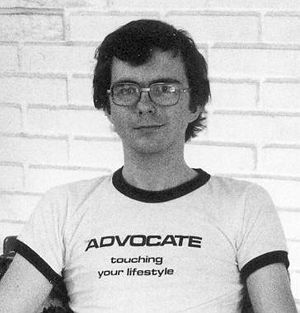
Thomas Kraemer
thomaskraemer.blogspot.com
